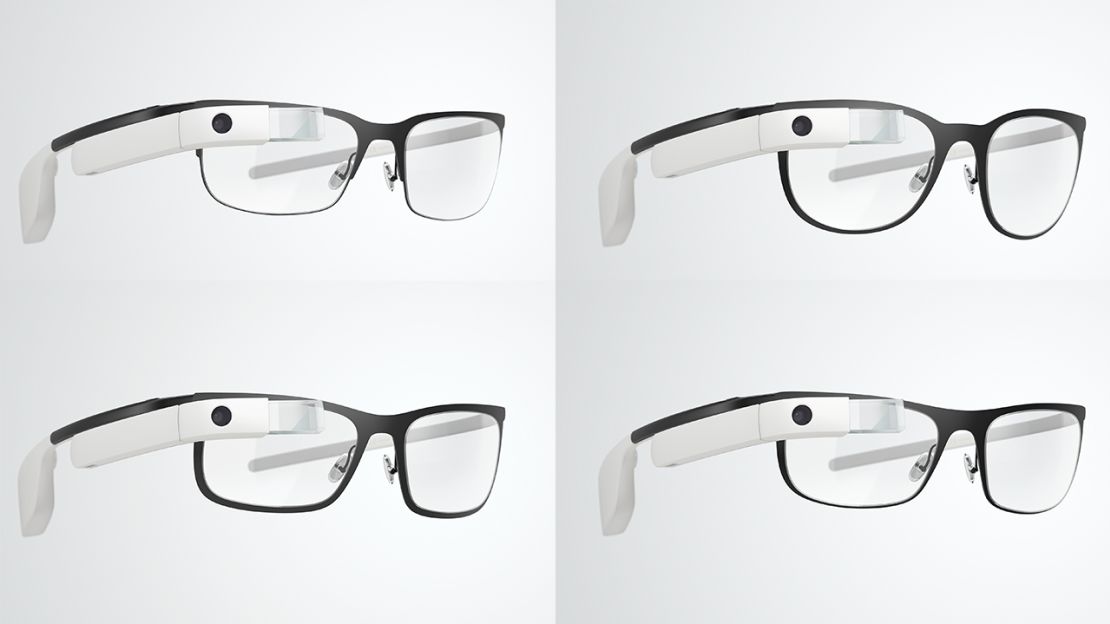Story highlights
Google says it will add Google Glass options for prescription glasses
Lenses will be available in a set of newly designed frames that will cost $225
Move is the latest attempt by Google to make its connected eyewear more fashionable
But the Internet-enabled glasses still aren't welcome everywhere
Google Glass’s vision for its future is coming into focus.
On Tuesday, Google announced it will add Google Glass options for prescription glasses, its most requested feature since it launched the face-mounted computers last year.
The move is the latest attempt by Google to make the beta version of its connected eyewear more fashionable and consumer friendly before it releases the product to the broader public toward the end of 2014.
The prescription lenses will be available in a set of newly designed, fashion-conscious frames that will cost $225 each. This new Titanium line will include four frame shapes called curve, thin, split and bold. The outside of the Titanium frames is gray, but there are four options for subtle accent colors inside the frames. Google is also adding three options for sunglasses that will cost $150 each.
The actual Glass hardware, which can shoot video and projects Internet content such as e-mails, walking directions and sports scores onto a tiny screen above the wearer’s right eye, is staying the same for now. It was last updated in October, when the team made sure the design was modular and could attach to the right side of the Titanium glass frames.
You still can’t quickly pop Google Glass off one frame and onto another, because the process requires undoing a small screw. While the task is easy enough, the system is not meant for frequent frame changes. Google is betting that people will be so comfortable wearing Google Glass that they won’t have to choose between prescription glasses and Google Glass.
“We’re going to reach some day, hopefully it will be soon, where people will wonder ‘why would I want traditional glasses? They don’t do X, Y or Z,’ ” said Google Glass Product Director Steve Lee.
Fusing Google Glass with prescription lenses could lead to its own set of problems, however, because wearers can’t take them off without limiting their vision, and the Internet-enabled glasses aren’t welcome everywhere.
Earlier this month, an Ohio man was questioned by local and federal law enforcement for wearing his Google Glass during a movie. The authorities suspected he was secretly recording the film until he explained the eyewear was turned off and connected to a pair of prescription frames. (He had purchased the custom frames for $600 through a third party.)
Driving while wearing Glass is also a thorny issue in many states, including California, where a woman was ticketed last year for wearing the device while behind the wheel. The citation was dismissed in court, but since many people need their prescription glasses to drive, there could be an uptick in the number of motorists sporting Google Glass.

Google is confident these types of issues will be resolved as Glass becomes more common place and people learn to recognize when the device is turned on or off. Currently there is no indicator light but when the device is on, other people can see a faint light on the Glass screen.
The company hopes venues and states hostile to Glass might even embrace it down the road. For example, there’s a Glass app called Drive Safe Google Glass that can wake drivers up if it detects they are falling asleep. That might appeal to law enforcement. Theaters could embrace the technology as a way to deliver close captioning for movies to certain audience members.
“I think you need to give the technology a chance to breathe and evolve,” said Google Glass spokesperson Chris Dale.
Prescription glasses can be pricey without insurance, so Google has struck a deal with vision benefits company Vision Service Plan, commonly known as VSP, to add coverage for wearers of the new specs. Insurance reimbursements will extend only to the frames and prescription lenses and can’t be used toward the Glass device itself, which still costs $1,500.
The new frames were designed in-house by Google employees on the Glass team, despite earlier rumors of a possible partnership with hip eyewear retailer Warby Parker. Going forward, the company does hope to work with third-party eyewear companies so partners can create their own Google Glass compatible products.
Even with the regular-looking new frames, someone wearing Google Glass still stands out. In the future, it might be possible to shrink the hardware down so that it’s more subtle, but Google doesn’t necessarily think that’s what all users will want. More modular designs and partnerships with third parties could expand the options so that a Glass wearer could decide between wearing an obvious look or going undetected.
“Sometimes I want to go out and I want to be seen, I want people to talk to me about Glass. I’ve actually found glass to be the most social experience ever,” said Lee. “But other times I just want to go about my business, stay low key.”









